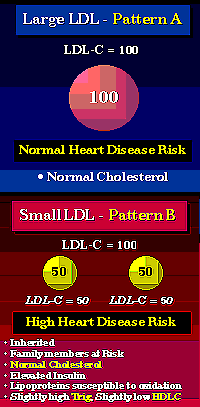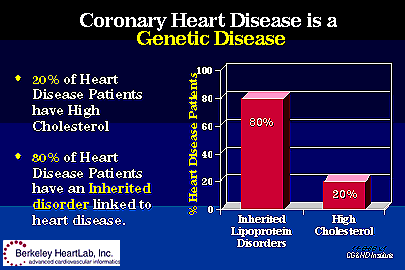|
Because of certain inherited genetic traits, an extreme low fat/high
carbohydrate diet can, for some individuals, actually increase the risk of
heart disease, says a scientist with the U.S. Department of Energy’s
Lawrence Berkeley National Laboratory (Berkeley Lab).
 |

INDIVIDUALS WHO ARE BORN WITH OR DEVELOP PATTERN B HAVE A HIGHER
HEART DISEASE RISK
Slide courtesy of Berkeley HeartLab
|
Speaking at an international workshop on diet and gene interactions
sponsored by the U.S. Department of Agriculture (USDA), Dr. Ronald Krauss,
head of the Department of Molecular Medicine in Berkeley Lab’s Life
Sciences Division, reported on the recent findings of his research group
in which it was shown that in genetically susceptible individuals, an
extreme low-fat/high-carbohydrate diet can produce metabolic reactions
that cause a change in the cholesterol profile of their blood. An extreme
low-fat diet was defined as one in which fat comprised less than 25
percent of the total daily calorie intake.
In these cases, patients with a "pattern A" profile --
meaning the low-density lipoproteins LDLs or the "bad"
cholesterol in their blood are predominantly made up of relatively large
and more buoyant particles -- will shift to a "pattern B"
profile, in which most of the LDLs are smaller, more densely packed.
Earlier studies by Krauss and others have already established that the
pattern B profile poses a much greater risk of heart disease than the
pattern A.
"Tests for these genetically susceptible traits are not widely
available," says Krauss. "A clue is if there are elevated levels
of triglycerides (another type of blood fat linked to heart disease) and
lowered levels of high-density lipoproteins (HDLs or the "good"
cholesterol) when a patient goes on a very low-fat/high-carbohydrate
diet."
Heart disease remains the number one cause of death and disability in
the United States and increasing numbers of Americans, especially those
over 50, have turned to diets aimed at lowering LDL cholesterol levels as
a means of reducing the risk. While the effects of such dietary changes
are beneficial to the population at large, these effects can vary widely
among individuals, according to Krauss.
"Studies of dietary effects on LDL cholesterol must take into
consideration that LDL is comprised of distinct subclasses that differ in
particle size and density, and that there is variation in the distribution
of these subclasses among individuals," he says. "Small LDL
particles appear to have a great atherogenic potential than large LDL
particles by virtue of reduced receptor-mediated clearance, and higher
arterial transport, proteoglycan binding, and oxidative
susceptibility."
The interaction between diet and genes and how this interaction affects
the two LDL subclass patterns may help to explain why there can be so much
variability in the effects of low-fat diets on the risk of heart disease.
For patients who started out with the pattern B cholesterol profile, the
study by Krauss and his research group showed that an extreme
low-fat/high-carbohydrate diet can reduce the number of circulating small
LDL particles which in turn reduces the risk of heart disease. LDL
particles carry cholesterol through the blood stream and deposit it along
arterial walls, creating a waxy buildup that can eventually restrict the
flow of blood to the heart.
For patients who started out with the pattern A cholesterol profile,
however, Krauss and his research group found that an extreme low-
fat/high-carbohydrate diet worked to reduce the cholesterol content of the
LDL particles circulating in the blood. This depletion in the composition
of the LDL particles resulted in a downsizing that in turn led to a
conversion from the pattern A to the pattern B profile.
"Studies in families have indicated that LDL subclass patterns are
influenced by major genes, and linkage of LDL particle size phenotypes to
several candidate genes have been reported," says Krauss.
"However, overall heritability of LDL particle sizes is less than 50
percent, consistent with the strong influence of modifying factors on the
expression of LDL subclass patterns."
Previously, these modifying factors were listed as age and gender, plus
certain metabolic conditions that affect triglyceride levels such as
abdominal adiposity and resistance to insulin. To these factors can now be
added diet, says Krauss.
Results of the study by Krauss and his collaborators were originally
reported in the June 2000 edition of the American Journal of Clinical
Nutrition. Krauss’ coauthors on that paper were Darlene Dreon,
Harriet Fernstrom, and Paul Williams.
Berkeley Lab is a U.S. Department of Energy national laboratory located
in Berkeley, California. It conducts unclassified scientific research and
is managed by the University of California.
|

Slide courtesy of Berkeley HeartLab
|
|


